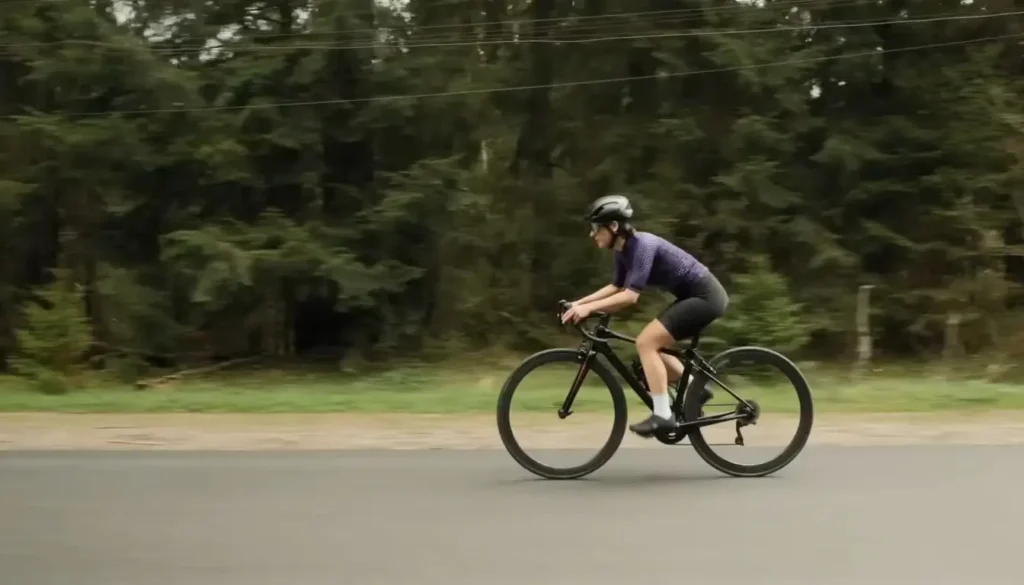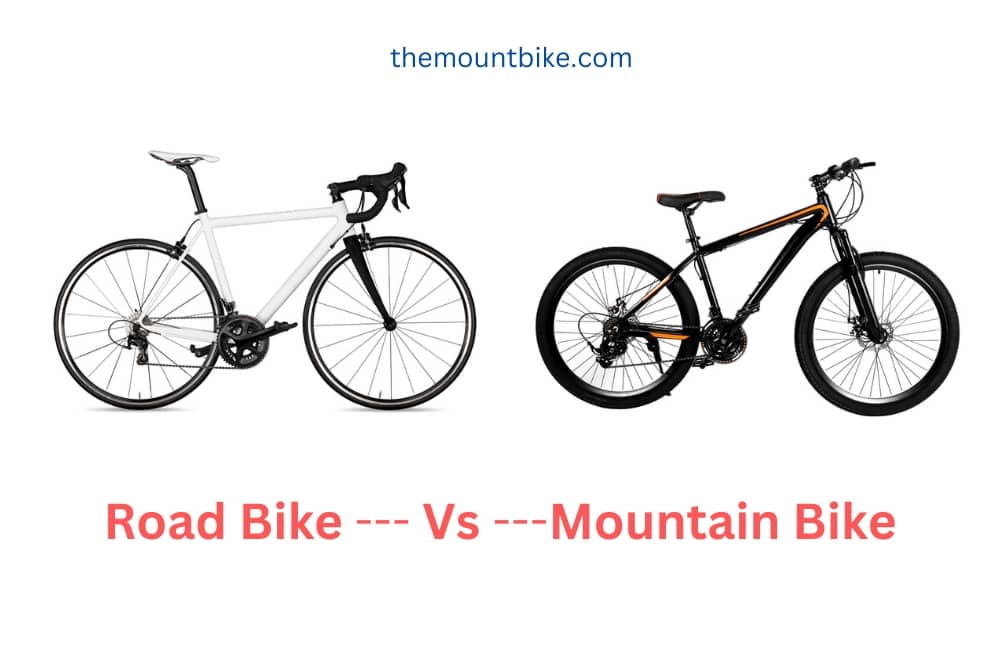Biking is an excellent form of exercise that offers numerous health benefits, including improved cardiovascular health, increased endurance, and strengthened leg muscles. However, deciding between a road bike and a mountain bike can be challenging when choosing a bike for exercise. Both bikes have unique strengths and weaknesses, making them suitable for different workouts.
This article will explore the pros and cons of road bikes vs. mountain bikes for exercise. We’ll take a closer look at each bike’s benefits, including the type of terrain it is best suited for, the level of intensity it offers, and the overall riding experience.
What is a Road Bike?
A road bike is a type of bicycle designed for smooth, paved surfaces such as roads, bike paths, and bike lanes. Road bikes are built for speed and efficiency, with lightweight frames, narrow tires, and drop handlebars that allow the rider to adopt an aerodynamic position and reduce wind resistance.
Road bikes are typically used for racing, long-distance rides, and endurance events. They come in various designs and configurations, including traditional road, aero, and endurance bikes, each offering different benefits and features depending on the intended use.
Advantages of Using a Road Bike for Exercise

Efficient workout
Riding a road bike can provide an intense cardio workout that targets several muscle groups, including the legs, glutes, and core. It can also improve your cardiovascular health and endurance.
Low-impact exercise
Unlike running or other high-impact exercises, cycling is a low-impact activity that is gentle on the joints. It is an excellent option for individuals who want to exercise without putting too much strain on their knees or ankles.
Weight loss
Cycling can help you burn calories and lose weight. Riding a road bike at a moderate pace can burn up to 500-600 calories per hour, depending on your weight and workout intensity.
Versatility
Road bikes can be used for various workouts, including long-distance rides, interval training, and hill climbs. They are also suitable for commuting and transportation, making them a versatile investment.
Enhanced mental health
Cycling can improve mood, reduce stress and anxiety, and boost mental health. Combining physical exercise and fresh air can help you clear your mind and feel more relaxed.
Better-quality balance and coordination
Riding a road bike requires balance and coordination, which can improve with practice. This can translate to better stability and coordination in other areas of your life.
Limitations of Using a Mountain Bike for Exercise
Less Speed
Mountain bikes are heavier and have wider tires with more aggressive tread patterns, making them slower than road bikes. This can be a disadvantage if you’re looking to ride longer distances or improve your speed.
Limited Use on Paved Surfaces
Mountain bikes are designed for off-road terrain and are not ideal for riding on paved surfaces. They can be slower and less efficient on smooth roads, which can be a disadvantage if you want to ride more.
Less Comfortable
Mountain bikes are designed for rough terrain, and as such, they are typically less comfortable than road bikes. This can be a disadvantage if you want to do longer rides or have back or joint issues.
Limited Carrying Capacity
Mountain bikes typically lack racks or other storage options, limiting their usefulness for commuting or carrying items during rides.
Less Efficient Pedaling
The wider tires and heavier frames of mountain bikes can make pedaling less efficient, which can be a disadvantage if you want to improve your pedaling technique or efficiency.
Limitations of Using a Road Bike for Exercise

- Road bikes are exclusively engineered to perform optimally on paved surfaces and are unsuitable for rugged terrains with bumps and obstacles.
- Road bike design aims to maximize speed and efficiency, often at the expense of rider comfort. Consequently, extended rides can cause discomfort, particularly for those with back or joint issues.
- The absence of racks or storage options is a typical feature of road bikes, limiting their practicality for commuting or transporting items while cycling.
- Due to their specialized design and components, road bikes are pricier than other bicycle types.
- Road bikes are engineered solely for road riding and may be less versatile for other exercise or transportation, such as mountain biking or commuting.
- Road bikes are built to be lightweight and fast, which can compromise their durability, making them less suitable for heavy use or rough riding conditions.
Recommended Exercises for Road Bikes
- Interval Training
- Hill Climbing
- Endurance Riding
- Cadence Training
- Sprint Training
- Group Riding
- Tempo Training
- Fartlek Training
- Time Trials
- Recovery Rides
What is a Mountain Bike?
A mountain bike is designed to be ridden off-road on rough terrain such as mountains, hills, and dirt trails. It typically features wide tires with deep treads, suspension systems to absorb shocks and vibrations, and strong brakes for effective stopping power. Mountain bikes come in various styles, including hardtail (with only front suspension), full suspension (with both front and rear suspension), and rigid (without suspension). They also often have a lower gear range to tackle steep climbs and technical descents.
Advantages of Using a Mountain Bike for Exercise
Full-body workout
A mountain bike provides a full-body workout, engaging your legs, core, and upper body. This helps to build strength, endurance, and cardiovascular fitness.
Low-impact exercise
Cycling is a low-impact exercise that puts less stress on your joints than other activities like running. This makes it a great option for people with joint problems or injuries.
Outdoor activity
Mountain biking is an excellent way to enjoy the outdoors and explore nature. It can be a great stress reliever and provide mental health benefits.
Versatility
Mountain bikes can be ridden on various terrains, from smooth trails to rocky terrain. This versatility allows you to vary your workout and target different muscle groups.
Social activity
Mountain biking can be a social activity, providing opportunities to ride with friends or join cycling groups in your area.
Customizability
Mountain bikes can be customized to fit your body and riding style, ensuring a comfortable and efficient ride.
Recommended Exercises for Mountain Bike
- Hill Repeats
- Technical Trail Riding
- Endurance Riding
- Intervals
- Downhill Riding
- Uphill Sprints
- Cornering Drills
- Bunny Hops
- Rock Garden Riding
- Jumps and Drops
Road Bike Vs Mountain Bike

Frame Geometry
The main difference in frame geometry between road and mountain bikes is that road bikes are built for efficiency and speed on smooth pavement, while mountain bikes are built for stability and handling on rough terrain.
Road bike frames are typically longer and lower for a more aerodynamic riding position, while mountain bike frames are shorter and higher for better control and maneuverability on uneven trails. The differences in frame geometry reflect the intended use and terrain for each type of bike.
Road Bike Vs. Mountain Bike:
Wheels and Tyrese
Road bikes and mountain bikes have distinct differences in their wheels and tires. Road bikes typically have narrow, smooth tires that optimize speed and efficiency on pavement, whereas mountain bikes have wider, knobbier tires that provide better traction on rough terrain.
Road bike wheels are typically larger and lighter, while mountain bike wheels are smaller and heavier to provide more stability and strength. These variations in wheels and tires reflect the bikes’ intended use and terrain.
Suspension
There is a significant difference between road bikes and mountain bikes regarding suspension. Mountain bikes have front and rear suspension systems that absorb shock on rough terrain. In contrast, road bikes typically have no suspension and rely on narrow tires and frame geometry to absorb shock.
The suspension system of a mountain bike adds weight and complexity but allows for smoother rides on rocky, bumpy trails—road bikes’ lack of suspension results in lighter weight and better efficiency on smooth roads.
Seats
Road bike seats are generally narrower and firmer, designed for a more aerodynamic riding position on smooth pavement. Mountain bike seats are wider and cushioned for a more upright riding position on rough terrain.
Additionally, mountain bikes often have suspension systems in the fork and frame, which provide shock absorption on bumpy trails. These alterations replicate the bikes’ intended use and the varying demands of different types of riding.
Riding Position
The riding position is a notable difference between road bikes and mountain bikes. Road bikes are designed for speed and efficiency and feature a lower riding position, with the handlebars positioned lower than the saddle.
Mountain bikes have a more upright riding position, with the handlebars positioned higher than the saddle. This allows for better control and visibility on rough terrain. The change in riding position imitates the bikes’ intended use and terrain, with road bikes optimized for paved surfaces and mountain bikes for off-road adventures.
Handlebars
There are also significant differences between handlebars on road bikes and mountain bikes. Road bikes typically have drop handlebars, allowing riders to position their hands low and aerodynamically for speed and efficiency.
In contrast, mountain bikes generally have flat or riser handlebars, providing more stability and control in technical terrain. The handlebar alterations reflect the intended use of each bike, with road bikes prioritizing speed and mountain bikes prioritizing handling and stability.
Gearing and Brakes
Road and mountain bikes have different gearing and brake systems to suit their terrains. Road bikes usually have higher gearing ratios, allowing faster speeds on smooth, flat surfaces. They typically have rim brakes, which are lightweight and efficient but less powerful than disc brakes.
On the other hand, mountain bikes have lower gearing ratios for climbing steep hills and navigating rough terrain. They commonly have disc brakes that offer superior stopping power and perform better in wet and muddy conditions. Ultimately, the choice between the two types of bikes will depend on the rider’s intended use and preferred riding style.
Where Can I Burn More Calories?
Mountain biking and road biking can burn significant amounts of calories, but the number of calories burned will depend on several factors, such as weight, ride intensity, duration, and terrain.
Mountain biking typically involves more challenging terrain and requires more exertion and strength, which can result in burning more calories. The constant changes in incline and the need to navigate obstacles also increase the intensity of the workout. However, this can also mean that you can only ride for a short time as you would on a road bike.
On the other hand, road biking provides a smoother ride and allows you to cover more distance in a shorter amount of time. This means you can ride longer and potentially burn more calories overall.
Mountain biking and road biking can provide an effective cardiovascular workout and help burn calories.
Which is Better for Building Muscles?
Mountain biking is a more intense, high-intensity workout involving much climbing, jumping, and navigating rough terrain. This can help build leg muscles, particularly in the quads, hamstrings, and glutes, and strengthen your core and upper body muscles as you navigate the terrain.
On the other hand, road biking is a more low-impact, endurance-focused workout that involves covering long distances at a steady pace. This can help build leg muscles, particularly in the calves and thighs, and improve cardiovascular fitness and endurance.
Mountain biking may be a better option if you’re looking to build muscle mass, as it involves more intense, high-intensity efforts. However, road biking may be a better choice if you’re looking to build endurance and improve overall fitness. Ultimately, the best option is the one you enjoy most and fits your fitness goals and lifestyle.
Which Is Better for Exercise?
Both mountain biking and road biking are great for your health and offer numerous benefits. They are both excellent forms of cardiovascular exercise that can improve your heart health, lung function, and overall fitness. Both activities can also help reduce stress, improve mental health, help with weight management, and reduce the risk of chronic diseases such as diabetes, high blood pressure, and obesity.
Mountain biking may be better if you enjoy the outdoors, nature, and adventure. It offers the added benefits of exposure to fresh air, vitamin D from sunlight, and the mental benefits of being in nature. Road biking can be better if you prefer more structured, low-impact exercise. It’s also great for those looking to improve their endurance and participate in long-distance rides or races.
Frequently Asked Question
1. Is Mountain Biking or Road Biking Better for Weight Loss?
Both mountain biking and road biking can help with weight loss, as they are both forms of cardiovascular exercise that burn calories. However, mountain biking may be more effective for weight loss due to the workout’s more intense, high-intensity nature.
2. Can Road Biking Help Build Leg Muscles?
Road biking can help build leg muscles, particularly in the thighs and calves. However, mountain biking may be more effective for building leg muscles due to the more varied terrain and higher intensity workout.
3. Is Mountain Biking or Road Biking Harder?
Mountain biking is generally more physically demanding and challenging than road biking due to the more varied terrain, technical skills required, and higher intensity workout.
4. Which is Better for Improving Cardiovascular Fitness, Road Biking or Mountain Biking?
Both road biking and mountain biking are excellent forms of cardiovascular exercise that can improve heart health and overall fitness. However, road biking may be more effective for improving cardiovascular fitness due to the longer, sustained efforts and consistent pacing.
5. Can Mountain Biking be Dangerous?
Mountain biking can be more dangerous than road biking due to the more challenging terrain and higher risk of falls and injuries. However, with proper training, safety gear, and caution, the risks can be minimized, and mountain biking can be enjoyed safely as a thrilling and exciting form of exercise.

I am Ryan Ford, a mountain biking enthusiast who loves to explore the outdoors. I also like to go on adventures with friends and anything else that involves being outside. I love my bike because it gets me out of the house and gives me an opportunity to enjoy nature.

